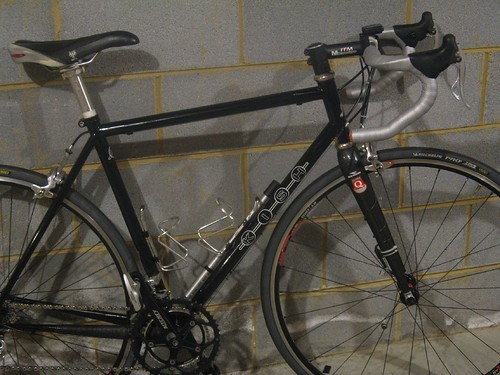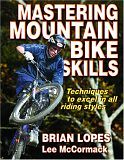Initial impressions of compact crankset
In an earlier post I have shared my thoughts on possibly going to a compact crankset for our hilly terrain.
I got an ebay Ritchey Pro WCS compact crankset which came with a 34t ring. I also got an additional 36t ring to have two options. The crankset required an Octalink BB and I found a lightly used ultegra.

First impressions/installation issues
The Ritchey WCS pro is one of the best values out there for a compact crankset. Supposedly very stiff, decent weight, and a great price tag. The Ultegra octalink BB, while 'obsoleted' by Shimano has a great track record for durability and function and are still readily available at very reasonable prices.
The crankset is sharp looking. I'd have gotten silver if it was available though. The box came with the self extracting hardware and crank bolts. I am scared of those self extracting things and just use a crank removal tool, but I did put the dust caps in.
I've had some problems keeping the crank bolts staying tight. Either I need some more locite or need to switch to steel crank bolts.
It was slightly difficult to get the crankset seated on to the ocatlink spines but it finally installed properly. There is some chainring wobble inherent in the crank arms. This made adjusting the front derailleur more diffcult and I'm just accepting it.
My existing front derailleur was an old Campy Chorus. It had some serious play in it. I just could not get the thing to shift up to the big ring very well at all. I figured that it was just worn out. Since I needed a new one anyway I figured I'd go with one of those compact specific front derailleurs and found an FSA C-16.
God what a POS. Stay away. It did nothing to improve the shifting up to the big ring. I returned it for a Campy Record and after much tweaking I got it working pretty well. It's still not the quickest or smoothest going up to the big ring, but it's not bad.
From my forum searches it seems that if you want the best shifting it's better to stay with components from the same manufacturer. Shimano cranksets/front derailleur combinations 'seemed' to have the best shifting performance from the forum chatter. If you go Campy, the campy compact front derailleurs seem to only work with Campy compact cranksets. And Sram works with Sram. Regular campy and shimano front der. seem to work with other 3rd party cranksets and my current experience supports this. Even though the 34/50 combo falls outside the specs of a regular campy front der max capacity.
riding experience
It's a pretty big jump from a 50t to a 34t. Consequently, when you shift from the 50t to the 34t you need to also grab several gears in the back to keep from spinning out.
I've got a 27t in the back. And even with all the steep hills around here the 34t might be a tad overkill. However, I am going to save it for this. In fact the Mountains of Misery is the whole reason I've been focusing on this issue. It is 102 or 103 miles and the last 3-4 miles are up a Cat 0-Cat1 climb.
Shifting from the 50t to the 34t is fine and didn't have any issues with dropping a chain. If I did have any issues, I was going to get a Jump stop to mitigate chain drops. I got one for my wife who was plagued with chain drops and she hasn't had any issues so far.
I then put a 36T ring on there. The change in gearing when downshifting from the 50t to the 36t isn't as jarring as with the 34t and I don't have to grab as many gears. Shifting doesn't seem to be any better than with the stock 34t.
The climbing performance is excellent on some of the steep hills around here. Testing it out on a few of the grinders around here has confirmed my speculation that I'll climb faster with this lower gearing.
Provided that I've got the power to back it up. With strong legs, a good turnover can't be maintained. However w/o power to back it up, the lower gearing is almost a liability because it provides a lower geared bailout which is juust plain slower.
This is just like Lance. It's not that he spins fast. It's that he's got big power output and spinning fast.
The crankset allows me to find a gearing that supports a good pedal turnover. With my 39t/27 sometimes I just couldn't get a good enough turnover, and my spin would turn to the mash. While the mash might be good training sometimes it certainly is not fast for me.
It's not that it's super low gearing like a triple would provide. Super low gearing is not faster either. The 36t just takes enough of the edge off off the hill so I can get that more perfect spin. It still hurts to go hard. In fact it hurts more than the mashing because my HR doesn't seem to get that high at lower cadences. But it sure seems faster.
The 50t also allows me to stay in the big ring longer on some rollers that I might have had to downshift on. I really haven't had a chance to test it out on Harding Road or some of the other rolling routes around here, but so far I like it.
The one downside, as predicted, is long extended downhills. The lower top end means that I spin out and my downhill speed is limited.
I haven't really had the crankset on for very long but my initial impressions are good. The 34t is hanging on the wall and will go on a few weeks before MOM. I'll use it to spin 'slowly' up everything and save the legs for the backside of Mountain lake.
Initial impressions indicate that for terrain like we have out here, a 36t/50t with a 27t in the rear looks to be a great compromise. But regardless of 39t, 36t or 34t with weak/burned out legs is still the same thing.



0 Comments:
Post a Comment
<< Home